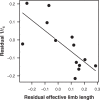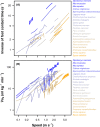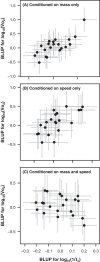Terrestrial locomotion energy costs vary considerably between species: no evidence that this is explained by rate of leg force production or ecology
- PMID: 30679474
- PMCID: PMC6345976
- DOI: 10.1038/s41598-018-36565-z
Terrestrial locomotion energy costs vary considerably between species: no evidence that this is explained by rate of leg force production or ecology
Abstract
Inter-specifically, relative energy costs of terrestrial transport vary several-fold. Many pair-wise differences of locomotor costs between similarly-sized species are considerable, and are yet to be explained by morphology or gait kinematics. Foot contact time, a proxy for rate of force production, is a strong predictor of locomotor energy costs across species of different size and might predict variability between similarly sized species. We tested for a relationship between foot contact time and metabolic rate during locomotion from published data. We investigated the phylogenetic correlation between energy expenditure rate and foot contact time, conditioned on fixed effects of mass and speed. Foot contact time does not explain variance in rate of energy expenditure during locomotion, once speed and body size are accounted for. Thus, perhaps surprisingly, inter-specific differences in the mass-independent net cost of terrestrial transport (NCOT) are not explained by rates of force production. We also tested for relationships between locomotor energy costs and eco-physiological variables. NCOT did not relate to any of the tested eco-physiological variables; we thus conclude either that interspecific differences in transport cost have no influence on macroecological and macrophysiological patterns, or that NCOT is a poor indicator of animal energy expenditure beyond the treadmill.
Conflict of interest statement
The authors declare no competing interests.
Figures



Similar articles
-
The relationship between energy expenditure and speed during pedestrian locomotion in birds: a morphological basis for the elevated y-intercept?Comp Biochem Physiol A Mol Integr Physiol. 2013 Jun;165(2):295-8. doi: 10.1016/j.cbpa.2013.03.027. Epub 2013 Mar 29. Comp Biochem Physiol A Mol Integr Physiol. 2013. PMID: 23545444
-
Energetics and mechanics of terrestrial locomotion.Annu Rev Physiol. 1982;44:97-107. doi: 10.1146/annurev.ph.44.030182.000525. Annu Rev Physiol. 1982. PMID: 7041812 Review.
-
Energetic costs of locomotion in bears: is plantigrade locomotion energetically economical?J Exp Biol. 2018 Jun 19;221(Pt 12):jeb175372. doi: 10.1242/jeb.175372. J Exp Biol. 2018. PMID: 29921569
-
Terrestrial movement energetics: current knowledge and its application to the optimising animal.J Exp Biol. 2016 May 15;219(Pt 10):1424-31. doi: 10.1242/jeb.133256. J Exp Biol. 2016. PMID: 27207950 Review.
-
Pedestrian locomotion energetics and gait characteristics of a diving bird, the great cormorant, Phalacrocorax carbo.J Comp Physiol B. 2008 Aug;178(6):745-54. doi: 10.1007/s00360-008-0265-9. Epub 2008 Jun 25. J Comp Physiol B. 2008. PMID: 18575869
Cited by
-
Goffin's cockatoos use object mass but not balance cues when making object transport decisions.Sci Rep. 2024 Nov 19;14(1):27265. doi: 10.1038/s41598-024-76104-7. Sci Rep. 2024. PMID: 39562587 Free PMC article.
-
Leg loss decreases endurance and increases oxygen consumption during locomotion in harvestmen.J Comp Physiol A Neuroethol Sens Neural Behav Physiol. 2021 Mar;207(2):257-268. doi: 10.1007/s00359-020-01455-1. Epub 2020 Nov 24. J Comp Physiol A Neuroethol Sens Neural Behav Physiol. 2021. PMID: 33236163
References
-
- Full R, Zuccarello D, Tullis A. Effect of variation in form on the cost of terrestrial locomotion. J Exp Biol. 1990;150:233–246. - PubMed
-
- Taylor C, Heglund N, Maloiy G. Energetics and mechanics of terrestrial locomotion. I. Metabolic energy consumption as a function of speed and body size in birds and mammals. J Exp Biol. 1982;97:1–21. - PubMed
-
- Taylor C, Schmidt-Nielsen K, Raab J. Scaling of energetic cost of running to body size in mammals. Am. J. Physiol. 1970;219:1104–1107. - PubMed
Publication types
MeSH terms
LinkOut - more resources
Full Text Sources


